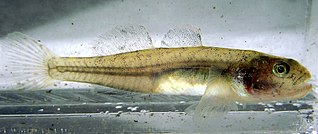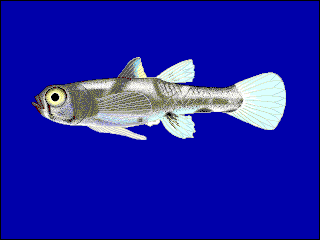
The round goby is a euryhaline bottom-dwelling species of fish of the family Gobiidae. It is native to Central Eurasia, including the Black Sea and the Caspian Sea. Round gobies have established large non-native populations in the Baltic Sea, several major Eurasian rivers, and the North American Great Lakes.

Eucyclogobius newberryi, the northern tidewater goby, is a species of goby native to lagoons of streams, marshes, and creeks along the coast of California, United States. The northern tidewater goby is one of six native goby species of California. It is protected under the Endangered Species Act as an endangered species of the United States since 1994.

The dwarf pygmy goby or Philippine goby is a tropical species of fish in the subfamily Gobionellinae from brackish water and mangrove areas in Southeast Asia. It is one of the smallest fish species in the world. Males reach maturity at a standard length of 0.9 cm (0.35 in) and can reach up to 1.1 cm (0.43 in) in standard length, while the females can grow up to 1.5 centimetres (0.59 in) in total length. Adults weigh around 4 milligrams (0.00015 oz). It is known as bia and tabios in the Philippines.

The sleepy goby is a species of fish in the family Gobiidae.
Knipowitschia croatica, the Neretva dwarf goby, is a species of fresh water ray-finned fish from the family Gobiidae. It is endemic to the western Balkans occurring in the Neretva drainage in Bosnia and Herzegovina and in Croatia in the Matica drainage, Neretva springs and Baćina lakes. This species can reach a length of 4.7 centimetres (1.9 in) SL.

The monkey goby is a species of goby native to the basins of the Black Sea and the Sea of Azov.

Padogobius bonelli, the Padanian goby, is a species of true goby from the family Gobiidae native to rivers of Croatia, Italy, Slovenia, and Switzerland, where it is usually found in areas with gravel substrates or dense vegetation along the edges. Males of this species can reach a length of 8.6 centimetres (3.4 in) TL while females only reach 7.5 centimetres (3.0 in) TL. This species' specific name honours the Italian naturalist Franco Andrea Bonelli (1784-1830), who had originally described this species as Gobius fluviatilis without realizing that this name was already being used for a different goby species, the monkey goby, which had been described by Pallas in 1814.

Lythrypnus dalli, commonly known as the blue-banded goby or Catalina goby, is a species of goby. It is native to the eastern Pacific where it is found from Monterey Bay, California to northern Peru, including the Gulf of California. It can be found in coastal waters at depths of from 0 to 76 metres with rocky substrates in which there are crevices for concealment. It is also known to hide amongst the spines of sea urchins. It is a bidirectional hermaphrodite and capable of rapidly switching sexes. This species can reach a length of 6.4 centimetres (2.5 in) TL. It can also be found in the aquarium trade. The specific name honours the malacologist William Healey Dall (1845-1927), who when trawling for specimens off Catalina Harbour, California, caught one of the type specimens.
Awaous grammepomus, the Scribbled goby, is a species of goby native to freshwater streams and rivers and brackish estuaries from Sri Lanka to New Guinea with a report of it occurring in Palau. This species can reach a length of 15 centimetres (5.9 in) SL. It is of minor importance to local commercial fisheries and can also be found in the aquarium trade.

Oxyurichthys microlepis, commonly known as the maned goby, is a species of goby native to tropical marine and brackish waters along the coasts of the Indian Ocean from Africa to the western Pacific Ocean where it occurs in estuaries and inshore waters to depths of about 75 metres (246 ft). It occurs in the Mekong Delta and is suspected to use the tidal flow up the river to reach as far inland as Cambodia. This species can reach a length of 13.5 centimetres (5.3 in) TL. It is of minor importance to local commercial fisheries and can also be found in the aquarium trade.

The Don tadpole-goby is a species of goby widespread in the basin of the Sea of Azov, specifically in the lower Don River and Tsimlyansk Reservoir. This species is found in rivers, reservoirs and river mouths, but is not known to enter seas. It is introduced and invasive upstream the Volga River, e.g. the Kuibyshev Reservoir. This fish can reach a length of 6.6 centimetres (2.6 in) SL. Life span is about one year.

The small-spine tadpole-goby is a species of goby, a small fish native to the eastern coasts of the Caspian Sea and the lower reaches of the Volga River up to Volgograd. In the sea it is recorded from the Cape Peschany to the Çeleken Peninsula and Ogurja Ada Island in the south. It is abundant the Volga River delta. This species can be found at depths down to 50 metres (160 ft) although the adults generally are not found deeper than 11 metres (36 ft). This species can reach a length of 6.6 centimetres (2.6 in) TL. The specific name honours the Azerbaijani ichthyologist A. A. Mahmudbekov, studied the fish of the Caspian Sea for much of his life.

The Gobionellinae are a subfamily of fish which was formerly classified in the family Gobiidae, the gobies, but the 5th Edition of Fishes of the World classifies the subfamily as part of the family Oxudercidae. Members of Gobionellinae mostly inhabit estuarine and freshwater habitats; the main exception is the genus Gnatholepis, which live with corals in marine environments. The subfamily is distributed in tropical and temperate regions around the world with the exception of the northeastern Atlantic Ocean, the Mediterranean Sea, and the Ponto-Caspian region. It includes around 370 species and 55 genera: Wikipedia articles about genera list about 389 species.
Knipowitschia radovici, the Norin goby, is a species of goby endemic to Croatia where it only occurs in the drainage basin of the Neretva River, where adults inhabit the deepest parts of the rivers in the strongest current. This species can reach a length of 2.8 centimetres (1.1 in) SL. The specific name honours the Ornithologist Dragan Radović, a friend of the author, Marcelo Kovačić, who encouraged him to sample in the waterbodies of Croatia.

Acanthogobius flavimanus is a species of fish in the goby family known by the common name yellowfin goby. Other common names include mahaze, Japanese river goby, Oriental goby, and spotted goby. It is native to Asia, where its range includes China, Japan, Korea, parts of Russia, Vietnam, and Malaysia. It has spread beyond its native range to become an introduced, and often invasive, species. It has been recorded in Australia, Mexico, and Florida and California in the United States.
The Slow goby is a species of goby fish endemic to the Gulf of California on the west coast of North America. It inhabits crevices in rocks and can be found in tide pools down to a depth of around 14 metres (46 ft). This species grows to a maximum length of 6.5 centimetres (2.6 in) SL. This species is the only known member of its genus.
Barbuligobius boehlkei, the Cryptic bearded goby, is a species of goby native to the Indian Ocean and the western Pacific Ocean where it can be found on sand-rubble substrates at depths of from 1 to 15 metres. This species grows to a length of 2 centimetres (0.79 in) SL. This species is the only known member of its genus. Its specific name honours James E. Böhlke (1930-1982) of the Academy of Natural Sciences of Philadelphia.

Gobiopterus is a genus of gobies native to fresh, marine and brackish waters of the coastal areas around the Indian and Pacific oceans.

Sicydium plumieri is a freshwater species of the goby native to the Antilles from Cuba to Trinidad and Tobago, though not recorded from all islands. This species can reach a length of 11 centimetres (4.3 in) TL. It is also known by the English common names sirajo, Plumier's stone-biting goby, and tri-tri goby. The young, which are regarded as a delicacy, are of commercial importance. The specific name honours Charles Plumier (1646-1704), a Franciscan friar and naturalist, who found the first specimens of the species on Martinique and Marcus Elieser Bloch based his species description on Plumier's drawings.
Gobiopterus birtwistlei is a species of goby belonging to the genus Gobiopterus. It is endemic to Singapore in the Western Pacific Ocean. According to Fishbase, it is currently the only described species of freshwater fish endemic to Singapore and is one of two described species of fish endemic to Singapore. It is demersal.














